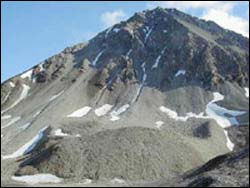Research team discovers life in Rock Glacier

An image of a rock glacier, the large hump in front of the mountain in photo taken at the Niwot Ridge Long-Term Ecological Research site west of Boulder, Colo. Photo courtesy Meredith Knauf, University of Colorado at Boulder
A University of Colorado at Boulder research team has discovered evidence of microbial activity in a rock glacier high above tree line in the Rocky Mountains, a barren environment previously thought to be devoid of life.
Found in an intermittent stream draining from the glacier, the evidence includes traces of dissolved organic material and high levels of nitrates, said Mark Williams, a fellow at CU-Boulder’s Institute of Arctic and Alpine Research. The high nitrate levels are believed to be a result of microbes metabolizing nitrogen within the glacier, said CU-Boulder graduate student Meredith Knauf.
Rock glaciers are large masses of rock debris interspersed with ice in the high mountains of temperate areas. Moving at speeds of just inches or a few feet a year, they require an extremely cold environment, large amounts of rock debris and enough of a slope to allow them to slide.
“This is a very surprising finding, something we did not expect,” said Williams. “The upshot is that we have shown that rock glaciers are not biological deserts as had been previously thought by scientists. This is one more example that microbes can live in the most extreme of environments.”
Williams said the microbial “signature” discovered by the team in the rock glacier in the Green Lakes Valley watershed roughly 30 miles west of Boulder, Colo., is similar to that found recently in semi-frozen lakes in the Dry Valleys of Antarctica. The unexpected discovery of microbes in that hostile Antarctica region has enthused scientists hunting for life in inhospitable environments, he said.
Both the amount of dissolved organic matter and nitrate levels from microbial activity in the rock glacier rose dramatically from the late spring to the early fall in 2003, said Knauf of CU-Boulder’s geography department. “This increase indicates that the biological signal is coming from meltwater inside the rock glacier, rather than from terrestrial microbial activity in the tundra around it,” she said.
Knauf gave a presentation on the discovery at the Fall Meeting of the American Geophysical Union held Dec. 13 to Dec. 17 in San Francisco.
The Green Lakes Valley watershed is part of the Niwot Ridge Long-Term Ecological Research site that is supported by the National Science Foundation. Niwot Ridge is the only one of NSF’s 26 LTER sites worldwide that is located in a sub-alpine and alpine environment.
The dissolved organic carbon molecules from the rock glacier, which are large and complex, are very similar in structure to molecules found by the researchers in Antarctica, said Knauf. “The microbial activity we are seeing appears to be much more like what researchers have found in the Dry Valleys of Antarctica than anything found in North American temperate areas,” she said.
Microbes, which are microscopic, single-celled organisms, have been found residing in boiling water in deep-sea ocean vents, clinging to ice in subterranean polar lakes and living in rocks two miles underground. Such microbes, known popularly as “extremophiles,” also have been found living inside of nuclear reactors and even in the brickwork of 4,800-year-old Peruvian pyramids.
Since Earth’s most extreme environments are thought by scientists to resemble environments found on distant planets, such examples of extremophiles on Earth have caught the interest of astrobiologists, said Williams. “Parts of Antarctica are seen as an analog to environments on Mars by researchers, and we see this rock glacier environment as a new analogue to Antarctica,” he said.
Microbes, which have been shown to metabolize elements like iron, nitrogen and sulfur, appear to require water in order to live, grow and reproduce. Previously at the Niwot Ridge study area, microbes living under the tundra snow pack have been shown to be active in sub-zero conditions, breaking down plant material and metabolizing nitrogen in the dead of winter, Williams said.
Following the discovery in the Green Lakes Valley, the CU-Boulder research team discovered evidence of microbial life in rock glaciers in southern Colorado and in Wyoming, said Knauf.
Other CU-Boulder researchers involved in the study include INSTAAR Fellow Nel Caine, graduate student Rose Cory and former graduate student Fengjing Liu.
Media Contact
More Information:
http://www.colorado.eduAll latest news from the category: Earth Sciences
Earth Sciences (also referred to as Geosciences), which deals with basic issues surrounding our planet, plays a vital role in the area of energy and raw materials supply.
Earth Sciences comprises subjects such as geology, geography, geological informatics, paleontology, mineralogy, petrography, crystallography, geophysics, geodesy, glaciology, cartography, photogrammetry, meteorology and seismology, early-warning systems, earthquake research and polar research.
Newest articles

Parallel Paths: Understanding Malaria Resistance in Chimpanzees and Humans
The closest relatives of humans adapt genetically to habitats and infections Survival of the Fittest: Genetic Adaptations Uncovered in Chimpanzees Görlitz, 10.01.2025. Chimpanzees have genetic adaptations that help them survive…

You are What You Eat—Stanford Study Links Fiber to Anti-Cancer Gene Modulation
The Fiber Gap: A Growing Concern in American Diets Fiber is well known to be an important part of a healthy diet, yet less than 10% of Americans eat the minimum recommended…

Trust Your Gut—RNA-Protein Discovery for Better Immunity
HIRI researchers uncover control mechanisms of polysaccharide utilization in Bacteroides thetaiotaomicron. Researchers at the Helmholtz Institute for RNA-based Infection Research (HIRI) and the Julius-Maximilians-Universität (JMU) in Würzburg have identified a…



